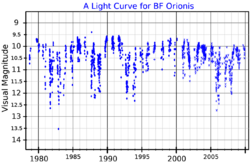Astronomy:BF Orionis
Coordinates: ![]() 05h 37m 13.2624s, −06° 35′ 00.5654″
05h 37m 13.2624s, −06° 35′ 00.5654″
| Observation data Equinox J2000.0]] (ICRS) | |
|---|---|
| Constellation | Orion |
| Right ascension | 05h 37m 13.2624s[2] |
| Declination | −06° 35′ 00.5654″[2] |
| Apparent magnitude (V) | 9.69 |
| Characteristics | |
| Evolutionary stage | Herbig Ae/Be star |
| Spectral type | A5II-III[3] |
| Apparent magnitude (g) | 10.38 |
| Astrometry | |
| Proper motion (μ) | RA: 0.873±0.025[2] mas/yr Dec.: 0.654±0.023[2] mas/yr |
| Parallax (π) | 2.6173 ± 0.0279[2] mas |
| Distance | 1,250 ± 10 ly (382 ± 4 pc) |
| Details | |
| Mass | 1.85+0.15−0.00[4] M☉ |
| Radius | 1.59±0.20[4] R☉ |
| Luminosity | 39[5] L☉ |
| Surface gravity (log g) | 3.5[6] cgs |
| Temperature | 8750[6] K |
| Rotational velocity (v sin i) | 37±2[3] km/s |
| Age | 17.14+2.80−0.00[4] Myr |
| Other designations | |
BD-06 1259, GSC 04778-01087, HIP 26403, 2MASS J05371326-0635005, Gaia DR2 3016930993175537536, Gaia EDR3 3016930993175889792, TYC 4778-1087-1 | |
| Database references | |
| SIMBAD | data |
BF Orionis is a young Herbig Ae/Be star in the constellation of Orion about 1250 light years away, within the Orion Nebula. It is the most massive star of the small birth cluster of four stars.[7]
Properties
BF Orionis is a Herbig Ae/Be star variable similar to UX Orionis. It is still accreting mass, producing about 2L☉ through the release of gravitational energy, and is surrounded by a massive, optically thick protoplanetary disk of 0.005±0.002M☉[4] visible nearly edge-on. The brightness of the star is strongly variable, with irregular deep minima down to 13th magnitude. The variations are suspected to be partly caused by a brown dwarf or massive planet embedded in the protoplanetary disk,[1] together with very large comets.[8]
Unlike typical Herbig Ae/Be stars, 90-95% of which do not have detectable magnetic fields, BF Orionis has a fairly strong longitudinal magnetic field of −144±21 gauss.[3] It also has small (0.11 magnitude) short-period, single-mode pulsations of the Delta Scuti type.[9]
References
- ↑ 1.0 1.1 Grinin, V. P.; Rostopchina, A. N.; Barsunova, O. Yu.; Demidova, T. V. (2010). "Mechanism for cyclical activity of the Herbig Ae star BF Ori". Astrophysics 53 (3): 367–372. doi:10.1007/s10511-010-9128-7. Bibcode: 2010Ap.....53..367G.
- ↑ 2.0 2.1 2.2 2.3 Brown, A. G. A. (2021). "Gaia Early Data Release 3: Summary of the contents and survey properties". Astronomy & Astrophysics 649: A1. doi:10.1051/0004-6361/202039657. Bibcode: 2021A&A...649A...1G. Gaia EDR3 record for this source at VizieR.
- ↑ 3.0 3.1 3.2 Wade, G. A.; Bagnulo, S.; Drouin, D.; Landstreet, J. D.; Monin, D. (2007). "A search for strong, ordered magnetic fields in Herbig Ae/Be stars". Monthly Notices of the Royal Astronomical Society 376 (3): 1145–1161. doi:10.1111/j.1365-2966.2007.11495.x. Bibcode: 2007MNRAS.376.1145W.
- ↑ 4.0 4.1 4.2 4.3 Guzmán-Díaz, J.; Mendigutía, I.; Montesinos, B.; Oudmaijer, R. D.; Vioque, M.; Rodrigo, C.; Solano, E.; Meeus, G. et al. (2021), "Homogeneous study of Herbig Ae/Be stars from spectral energy distributions and Gaia EDR3", Astronomy & Astrophysics 650: A182, doi:10.1051/0004-6361/202039519, Bibcode: 2021A&A...650A.182G
- ↑ Grinin, V. P.; Kozlova, O. V.; Natta, A.; Ilyin, I.; Tuominen, I.; Rostopchina, A. N.; Shakhovskoy, D. N. (2001). "Optical spectra of five UX Orionis-type stars". Astronomy and Astrophysics 379 (2): 482. doi:10.1051/0004-6361:20011280. Bibcode: 2001A&A...379..482G.
- ↑ 6.0 6.1 Mora, A.; Eiroa, C.; Natta, A.; Grady, C. A.; De Winter, D.; Davies, J. K.; Ferlet, R.; Harris, A. W. et al. (2004). "Dynamics of the circumstellar gas in the Herbig Ae stars BF Orionis, SV Cephei, WW Vulpeculae and XY Persei". Astronomy & Astrophysics 419: 225–240. doi:10.1051/0004-6361:20040096. Bibcode: 2004A&A...419..225M.
- ↑ Testi, L.; Palla, F.; Natta, A. (1998). "The onset of cluster formation around Herbig Ae/Be stars". arXiv:astro-ph/9811210.
- ↑ Shevchenko, V. S.; Ezhkova, O. V. (2001). "Long-Term Cyclicity of the Herbig Ae Star BF Ori: Giant Protocomets and Accretion from a Protoplanetary Disk". Astronomy Letters 27 (1): 39. doi:10.1134/1.1336861. Bibcode: 2001AstL...27...39S.
- ↑ Marconi, M.; Ripepi, V.; Alcala', J. M.; Covino, E.; Palla, F.; Terranegra, L. (2000). "Pulsation in two Herbig Ae stars: HD 35929 and V351 Ori". Astronomy and Astrophysics 355. Bibcode: 2000A&A...355L..35M.
 |


